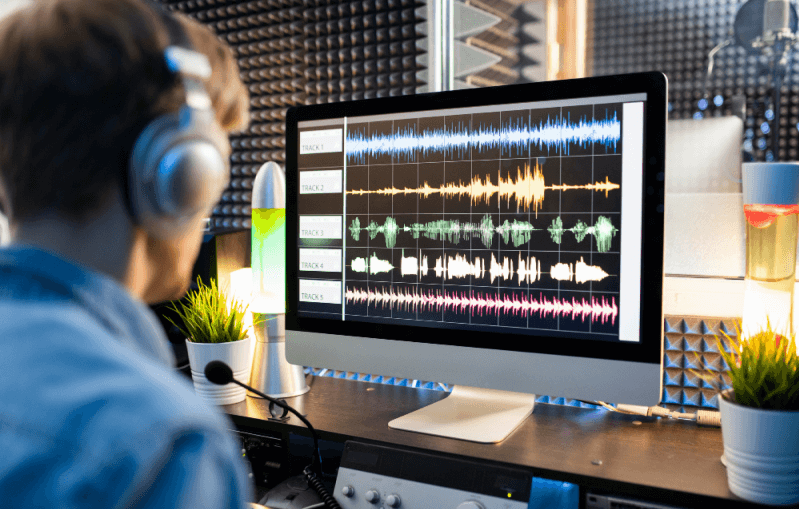Smart strategies to enhance events with audio visual charlotte nc
Comprehending the Inclusion of Audio Visual Modern technology in Today's Educational Environments
The assimilation of audio-visual innovation in academic settings has actually changed the mentor and finding out procedure. Educators currently have access to tools that satisfy various discovering styles, improving pupil involvement and collaboration. The unification of these modern technologies offers both possibilities and obstacles. Understanding how to effectively implement these tools is vital. What approaches can instructors employ to make the most of the advantages of audio-visual modern technology in their class?
The Advancement of Audio-Visual Modern Technology in Education
As educational needs evolved over the decades, audio-visual innovation went through significant improvements that reshaped the knowing environment. At first, tools such as film projectors and slide shows were the key ways of integrating aesthetic components into classrooms. These early modern technologies supplied instructors with the ability to existing info dynamically, yet they were restricted in access and interactivity.
With the development of videotape recorder in the 1970s, class began to incorporate taped lessons, broadening the extent of instructional resources. The introduction of individual computer systems in the 1980s further changed this landscape, permitting the creation of multimedia discussions and interactive understanding experiences.
The increase of the internet in the 1990s noted a zero hour, enabling real-time accessibility to a wide range of audio-visual products. Today, digital tools such as interactive white boards and on the internet discovering systems proceed to enhance the academic experience, fostering interaction and collaboration amongst students.
Advantages of Audio-Visual Devices for Diverse Discovering Styles
Audio-visual tools play a vital duty in providing to diverse discovering designs by improving aesthetic knowing and improving auditory involvement. By incorporating photos, videos, and audio, these technologies develop an even more comprehensive academic setting. This multifaceted strategy allows teachers to attend to the diverse preferences and requirements of students effectively.
Enhancing Visual Discovering
Interaction in the discovering process is markedly improved via making use of audio-visual devices, dealing with different discovering designs. These tools, such as videos, infographics, and interactive presentations, provide visual stimulations that assist understanding and retention. Visual learners, in specific, gain from the consolidation of photos and computer animations, which can streamline intricate principles and boost understanding. Additionally, audio-visual resources can highlight real-world applications, making finding out more appropriate and appealing. By integrating color, activity, and noise, teachers can create a vibrant learning environment that records trainees' interest and fosters deeper cognitive connections. Ultimately, the strategic usage of audio-visual modern technology not just sustains aesthetic knowing however also improves the total instructional experience for varied students.
Improving Auditory Involvement
A significant benefit of including audio-visual devices in education and learning is their capability to improve acoustic engagement among pupils. These tools, which encompass multimedia discussions, podcasts, and interactive audio components, satisfy various discovering designs, especially benefiting acoustic learners (audio visual charlotte nc). By integrating noise and narrative, educators can create immersive experiences that record trainees' attention and enhance comprehension. This involvement is vital, as it fosters a deeper understanding of the product and advertises retention. Furthermore, audio-visual tools can help with collaborative learning atmospheres, urging trainees to take part in conversations and share their understandings. Ultimately, the consolidation of audio-visual technology not just supports auditory interaction yet additionally enriches the total instructional experience, making finding out more dynamic and efficient for all pupils
Enhancing Interaction Via Interactive Understanding

Gamification components, such as tests and simulations, can boost inspiration and retention, making learning much more pleasurable and efficient. These techniques not just boost cognitive engagement but likewise provide to varied understanding designs, making certain that all pupils can participate meaningfully. Consequently, interactive knowing settings promote a feeling of community and belonging, inevitably leading to enhanced scholastic end results. With the assimilation of audio aesthetic modern technology, instructors can change traditional class right into vibrant rooms where pupils grow and actively shape their academic journeys.
Connecting Concept and Exercise With Multimedia Resources
Multimedia resources offer as an important link in between theoretical concepts and sensible application in instructional setups. By improving interaction, assisting in collaborative learning experiences, and sustaining diverse learning designs, these tools develop a more comprehensive and dynamic discovering atmosphere - audio visual charlotte nc. This approach not just promotes deeper understanding yet also prepares pupils for real-world obstacles

Enhancing Engagement Through Multimedia
Interaction in instructional setups considerably raises when trainers integrate multimedia sources right into their training strategies. Using videos, podcasts, and interactive presentations enhances the discovering experience, allowing students to attach with the product on multiple degrees. Multimedia resources deal with numerous discovering designs, offering aesthetic, auditory, and kinesthetic stimuli that can hold students' interest better than conventional lecture techniques. Additionally, these resources can streamline complex ideas, making them a lot more accessible and unforgettable. By incorporating multimedia, educators can create a dynamic class setting that promotes curiosity and inspires learners. Inevitably, the calculated use audio-visual technology offers to connect the space between theoretical expertise and sensible application, enriching the educational experience for both trainers and pupils.
Assisting In Collaborative Knowing Knowledge
Numerous researches show that joint understanding experiences noticeably improve student results when incorporated with multimedia resources. Multimedia tools assist in communication amongst trainees, enabling them to participate in analytic and vital thinking jointly. By making use of video conferencing, collaborative platforms, and interactive discussions, educators develop settings favorable to synergy and shared understanding. These innovations allow pupils to interact their ideas properly and receive immediate responses, promoting a deeper understanding of the subject matter. Additionally, multimedia sources can offer complex principles in more digestible layouts, promoting conversation and partnership. Because of this, the combination of collective discovering and audio-visual innovation not just improves the academic experience but also prepares students for real-world team effort characteristics, highlighting the value of participation and cumulative knowledge building and construction.
Sustaining Diverse Discovering Styles
While typical mentor techniques frequently satisfy a minimal series of finding out preferences, the combination of audio-visual innovation supplies a more comprehensive strategy to education and learning. By using multimedia resources such as video clips, interactive simulations, and digital presentations, teachers can address various discovering styles, consisting of visual, acoustic, and kinesthetic. This adaptability permits distinguished instruction, enabling students to engage with material in manner ins which reverberate with their individual choices. Additionally, audio-visual tools can facilitate deeper understanding by giving multiple depictions of complicated principles. Because of this, pupils who may deal with conventional techniques can locate alternate pathways to success, cultivating an extra fair learning setting that sustains academic achievement for all students.
Challenges in Applying Audio-Visual Innovation
Audio-visual technology holds terrific pledge for boosting instructional experiences, its implementation frequently comes across considerable difficulties. One main problem is the financial burden associated with getting and preserving such devices, which can stress budget plans, especially in underfunded organizations. Furthermore, insufficient training for teachers can hinder effective integration, leaving them ill-prepared to make use of the modern technology totally. Technical problems, such as software application breakdowns and compatibility issues, may also disrupt lessons and annoy both instructors and students. Moreover, varying levels of pupil accessibility to technology outside the classroom can develop variations in learning possibilities. The potential for over-reliance on modern technology may take away from vital training techniques, inevitably limiting the instructional experience. Attending to these challenges needs a complete method, consisting of sufficient financing, professional advancement, and fair access to sources, to guarantee that audio-visual innovation can be leveraged effectively in today's instructional settings.
Best Practices for Integrating Technology in the Class

Additionally, cultivating website an interactive atmosphere via collective tools urges student engagement and involvement. Utilizing varied audio-visual sources caters to numerous discovering designs, fitting visual, acoustic, and kinesthetic learners. Routinely reviewing the effect of modern technology on trainee knowing aids teachers refine their techniques and adjust to altering demands. Involving trainees in the option of innovation advertises possession and motivation. By adhering to these finest techniques, educators can produce a vibrant class atmosphere that efficiently incorporates modern technology and enhances the educational experience for all trainees.
The Future of Audio-Visual Modern Technology in Education And Learning
As classrooms progressively accept modern technology, the landscape of audio-visual devices in education and learning continues to develop (audio visual charlotte nc). Future improvements are anticipated to concentrate on better interactivity and personalization, allowing educators to tailor learning experiences to individual student needs. Developments such as augmented truth (AR) and virtual reality (VR) will likely offer immersive knowing atmospheres, improving trainee involvement and understanding
In addition, artificial intelligence (AI) is positioned to play a substantial duty in audio-visual modern technology by supplying real-time responses and flexible learning pathways. This combination may help teachers recognize and deal with pupil difficulties better. Cloud-based platforms will certainly promote much easier access to sources and collaboration amongst trainees and teachers, no matter location.
Along with these technological advances, specialist development for instructors will be essential, ensuring they are outfitted to use these devices efficiently. On the whole, the future of audio-visual innovation in education and learning guarantees to develop more vibrant, comprehensive, and impactful knowing experiences.
Regularly Asked Concerns
How Can Teachers Choose the Right Audio-Visual Equipment for Their Classrooms?
Picking suitable audio-visual devices needs teachers to evaluate their academic goals, think about pupil requirements, examine available innovation, and look for recommendations from peers or specialists, ensuring tools properly boost discovering and engagement within their details class environment.
What Budget plan Factors to consider Are There for Applying Audio-Visual Innovation?
Budget plan considerations for applying audio-visual technology consist of first acquisition prices, upkeep costs, training for team, and possible software program licensing charges. In addition, lasting investment in updates and substitutes need to likewise be factored into financial preparation.
Exist Specific Training Resources for Teachers on Audio-Visual Equipment?
Numerous establishments supply training resources for educators on audio-visual tools, including online programs, workshops, and educational guides. These sources aim to improve instructors' abilities and self-confidence in effectively integrating innovation into their training practices.
Exactly how Do We Measure the Performance of Audio-Visual Modern Technology in Discovering?
Gauging the effectiveness of audio-visual technology in discovering includes assessing student engagement, understanding, retention rates, and general academic efficiency. Studies, analyses, and observational studies can offer beneficial insights into its impact on educational results.
What Prevail Mistaken Beliefs Regarding Audio-Visual Technology in Education?
Typical misconceptions about audio-visual modern technology in education include the idea that it ensures interaction and finding out results, along with the assumption that all trainees profit equally, ignoring individual discovering choices and needs.